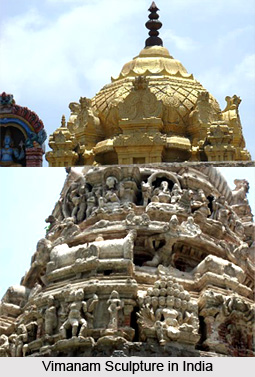 One of the prominent features of Western Chalukya sculptures is the vimanam. For instance the Jain Temple at Lakkundi is a fine instance of the tower sculpture or architecture. The vimanam of the Western Chalukya temples are generally massive in structure and the outer walls are adorned with vivid sculptures. In the Kalyani Chaulakya temples the miniature towers of both the Dravida and Nagara types have been generously used to beautify these units.
One of the prominent features of Western Chalukya sculptures is the vimanam. For instance the Jain Temple at Lakkundi is a fine instance of the tower sculpture or architecture. The vimanam of the Western Chalukya temples are generally massive in structure and the outer walls are adorned with vivid sculptures. In the Kalyani Chaulakya temples the miniature towers of both the Dravida and Nagara types have been generously used to beautify these units.
Simple pilasters have been put to use to decorate the vimanam walls that appear below the Dravidian structure. These pilasters display bold sculptures that have been carved on the surface so that they stand out in the background. The surfaces are embellished with impressive conventional sculptures. The surfaces frequent recesses and the projections have deep niches that have been filled up with sculptures. The walls of the vimanam have been broken up into concave and convex shapes. These divisions create a beautiful effect of light and shade. Such brilliant structural design has made the tower architecture of the Western Chalukyas famous.
The artisans of the period have experimented with different forms and some of the temples of the Western Chalukyas stand out because of their unique features. For instance the Muktesvara Temple at Chavudayyadanapura is famous for its `chhajja` and the Kasivisvesvara Temple at Lakkundi is well known for its ascending line of niches.



















